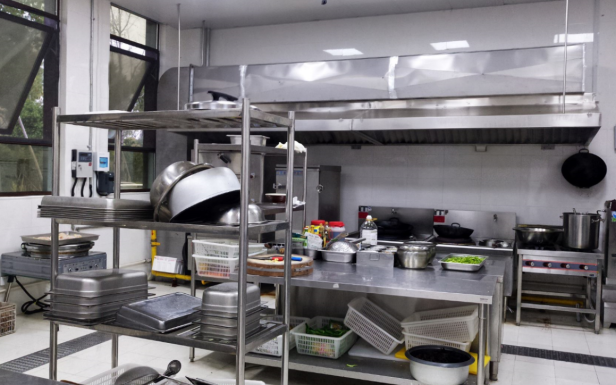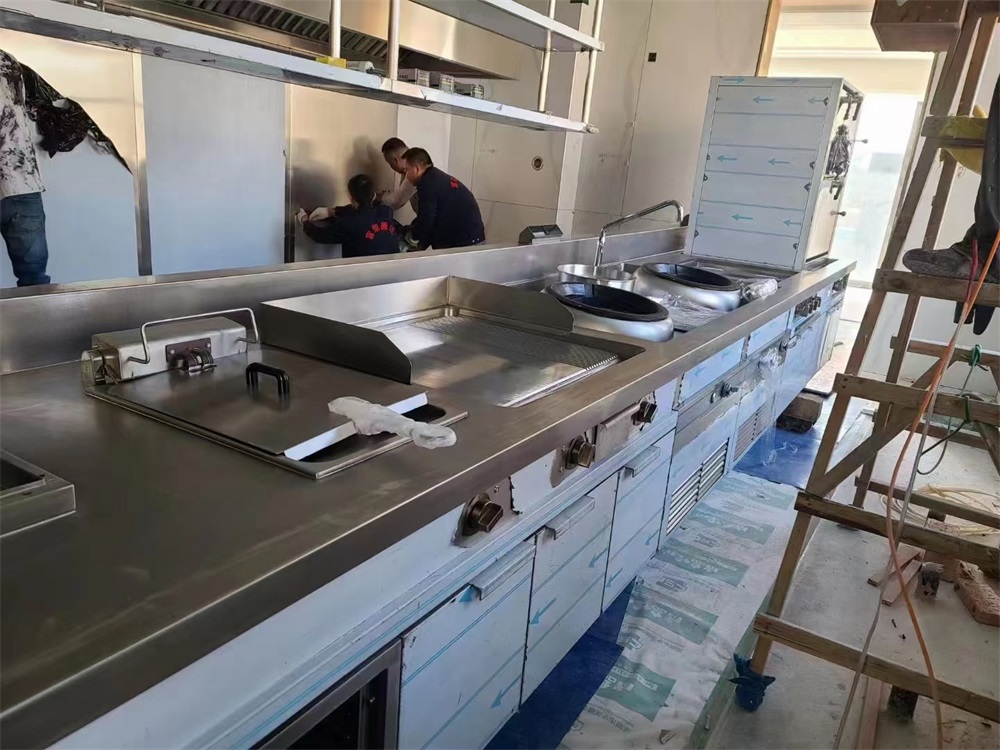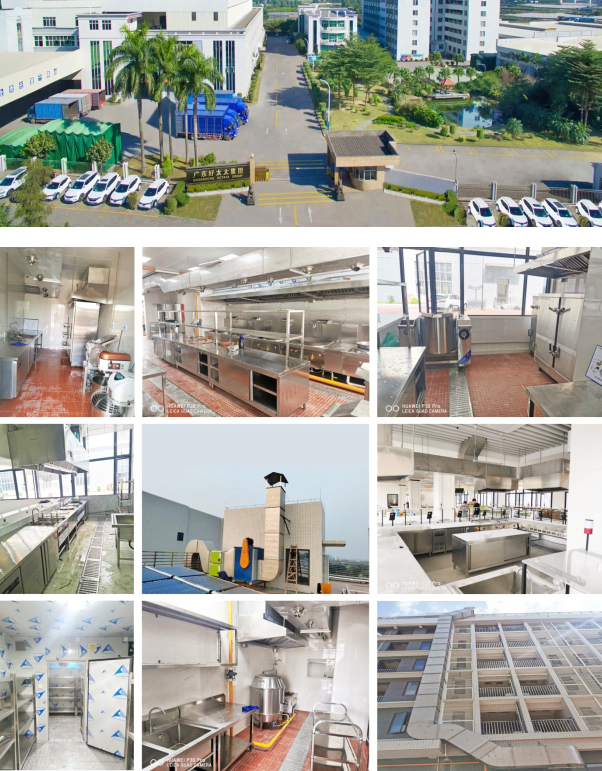Industrial kitchen equipment refers to the specialized appliances, tools, and machinery used in commercial food service operations. These are designed to handle high-volume cooking, food preparation, storage, and cleaning in settings like restaurants, hotels, catering services, institutional kitchens (such as in schools, hospitals, and prisons), and food processing plants. Industrial kitchen equipment is built to be more durable, efficient, and capable of handling larger quantities of food compared to household kitchen appliances.
Categories of Industrial Kitchen Equipment
1.Cooking Equipment
–Ranges and Ovens: Includes gas and electric ranges, convection ovens, combi ovens, pizza ovens, conveyor ovens, and deck ovens.
-Grills and Griddles: Flat-top griddles, charbroilers, and salamanders for grilling and searing.
-Fryers: Deep fryers and pressure fryers for frying large quantities of food quickly.
-Steam Cooking Equipment: Steamers, kettles, and combi steamers for healthy and efficient cooking.
-Microwaves and Speed Ovens: High-power microwaves and speed ovens for quick cooking and reheating.
2.Refrigeration Equipment
–Refrigerators and Freezers: Reach-in, walk-in, and undercounter units, as well as blast chillers for rapid cooling.
–Refrigerated Prep Tables: Sandwich/salad prep tables and pizza prep tables with refrigerated compartments for ingredients.
3.Food Preparation Equipment
-Mixers: Planetary mixers and spiral mixers for dough and batter preparation.
-Food Processors and Blenders: Commercial blenders, immersion blenders, and food processors for chopping, blending, and pureeing.
-Slicers and Cutters: Meat slicers, vegetable slicers, mandolins, and other cutting tools.
-Other Prep Equipment: Dough sheeters, peelers, choppers, and grinders.
4.Beverage Equipment
-Coffee Machines: Espresso machines and drip coffee makers for high-volume coffee service.
-Cold Beverage Dispensers: Juice and soda dispensers for serving cold beverages.
-Other Beverage Equipment: Ice machines, water boilers, and tea brewers.
5.Washing Equipment
-Dishwashers: Under-counter, conveyor, and glass washers for efficient cleaning of dishes, glasses, and utensils.
-Sinks and Faucets: Prep sinks, handwashing sinks, and mop sinks for various cleaning and sanitation tasks.
6.Storage and Shelving
-Shelving Units: Wire and solid shelving for organized storage of food, equipment, and supplies.
-Food Storage Containers: Bins, cambros, and other containers for safe food storage.
7.Safety and Sanitation
-Sanitizing Stations: Hand sanitizer dispensers and cleaning chemical dispensers for maintaining hygiene.
-Protective Gear: Cut-resistant gloves, aprons, and other protective clothing for kitchen staff.
8.Other Essential Equipment
-Smallwares: Pots, pans, cooking utensils, and cutting boards essential for food preparation.
-Specialty Equipment: Sous vide machines, vacuum sealers, smoking equipment, and other specialized tools for unique culinary techniques.
Importance of Industrial Kitchen Equipment
- Durability: Built to withstand the rigors of continuous use in a commercial environment.
- Efficiency: Designed to speed up cooking and preparation processes, helping kitchens run smoothly.
- Safety: Includes features to ensure the safety of kitchen staff, such as temperature controls and safety guards.
- Compliance: Meets health and safety standards required by food safety regulations.
- Scalability: Capable of handling large quantities of food, making them essential for high-volume food service operations.

Industrial kitchen equipment is very important for commercial kitchen.Their quality directly affects the functioning of the kitchen.Below is some advices for choosing industrial kitchen equipment:
1. Assess Your Needs
-Menu: Consider the type of food you will be preparing. Specific cuisines may require specialized equipment.
-Volume: Estimate the volume of food you will be preparing. High-volume operations need heavy-duty equipment.
-Space: Measure your kitchen space to ensure the equipment will fit comfortably without overcrowding.
-Work Flow: Plan the layout to optimize workflow and reduce unnecessary movement.
2. Quality and Durability
-Materials: Look for equipment made from high-quality, durable materials like stainless steel.
-Reputation: Choose reputable brands known for reliability and longevity.
-Warranty: Check the warranty terms and after-sales service.
3. Energy Efficiency
-Energy Ratings: Opt for energy-efficient appliances to reduce utility costs and environmental impact.
-Usage: Consider the energy consumption based on how frequently the equipment will be used.
4. Ease of Maintenance and Cleaning
-Design: Equipment with smooth surfaces, removable parts, and easy access can simplify cleaning.
-Maintenance: Consider the availability of parts and ease of servicing. Regular maintenance is crucial for longevity.
5. Safety Features
-Compliance: Ensure the equipment complies with local health and safety regulations.
-Safety Mechanisms: Look for features like automatic shut-offs, safety guards, and non-slip feet.
6. Cost and Budget
-Initial Cost vs. Long-term Value: Sometimes, higher initial costs can lead to better long-term savings due to lower maintenance and energy costs.
-Financing Options: Explore leasing or financing options if the budget is a constraint.
7. Technological Advancements
-Smart Features: Modern equipment often includes smart features like programmable settings, remote monitoring, and automated functions.
-Future-proofing: Consider equipment that can adapt to future needs or integrate with other systems.
8. Ergonomics and Usability
-User-Friendly: Ensure that the equipment is easy to use and does not require extensive training.
-Ergonomic Design: Choose equipment designed to minimize physical strain and enhance comfort for the staff.
9. Vendor and Supplier Reliability
-Reputation: Purchase from trusted vendors with good reviews and reliable customer service.
-Support: Check if the vendor offers installation, training, and ongoing support.
10. Environmental Considerations
-Eco-Friendly Options: Consider equipment that uses eco-friendly refrigerants, reduces waste, or has a smaller carbon footprint.
-Regulations: Ensure compliance with environmental regulations and standards.
Additional Tips:
1.Visit Trade Shows and Demos: Attend trade shows or request demos to see the equipment in action and ask questions.
2.Consult Industry Experts: Seek advice from consultants or industry professionals who can provide insights based on experience.
3.Read Reviews and Testimonials: Look for reviews and testimonials from other businesses to gauge real-world performance and reliability.
4.Plan for Growth: Consider equipment that can accommodate future growth or menu expansion.

Key trends in industrial kitchen equipment/Commercial kitchen equipment for 2024:
- Smart and Automated Equipment:
- With ongoing labor shortages, smart equipment that automates tasks is becoming essential. These devices ensure consistency and reduce the need for skilled labor by logging temperatures, uploading data, and sending alerts. Smart combi ovens and robotic systems for repetitive tasks, such as lifting fryer baskets, are examples of this trend (Foodservice and Hospitality Magazine) (National Kitchen Equipment).
- Space-Saving Appliances: Maximizing kitchen space is crucial, especially for smaller operations. Multi-functional appliances that combine several cooking methods into one unit, such as rapid-cook ovens and all-in-one countertop systems, are increasingly popular. These devices allow for diverse menu offerings without requiring large kitchen footprints (Foodservice and Hospitality Magazine) (National Kitchen Equipment).
- Sustainability: The focus on eco-friendly practices continues to grow. This includes sourcing ingredients from regenerative farms, reducing energy consumption, and utilizing waste-reduction equipment. Sustainable packaging and energy-efficient appliances are also key aspects of this trend, helping kitchens lower their environmental impact and cater to eco-conscious consumers (WebstaurantStore) (StartUs Insights).
- Contactless and Cloud Kitchens: The rise of contactless technology, accelerated by the COVID-19 pandemic, is transforming how kitchens operate. Systems for contactless ordering, such as QR codes and self-ordering kiosks, enhance customer convenience and safety. Additionally, cloud kitchens—commercial kitchens that prepare food exclusively for delivery—are becoming more prevalent, enabling restaurants to operate with lower overhead costs and meet the growing demand for delivery services (StartUs Insights).
- Food Waste Management: Reducing food waste is both an economic and environmental priority. Restaurants are adopting data-driven strategies and innovative technologies to minimize waste. This includes using predictive inventory systems and in-house organic waste management solutions, which help streamline operations and reduce costs while addressing sustainability goals (StartUs Insights).

Our company is a professional commercial kitchen equipments company.We have full range of industrial kitchen equipments for restaurant and hotel.



